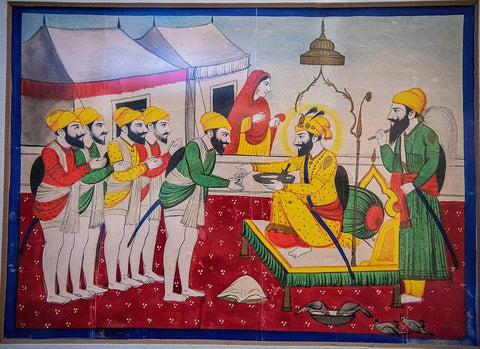Baisakhi is a significant festival in India, particularly for the Sikh community. It is celebrated with great enthusiasm as it marks the beginning of the Sikh New Year and has deep cultural and historical significance. The festival's Sikh connection dates back to the year 1699 when Guru Gobind Singh, the tenth Guru of the Sikhs, established the Khalsa Panth. This community of initiated Sikhs was trained to resist tyranny and oppression.
On the day of Baisakhi, a massive crowd of people had gathered around the divine seat of Guru Gobind Singh in Anandpur Sahib. The Guru delivered a powerful speech about his divine mission of restoring their faith and preserving the Sikh religion. He then drew his unsheathed sword and proclaimed that great deeds are always preceded by great sacrifice. He demanded one head as an oblation.
Initially, the congregants were hesitant, but eventually, one person offered himself. The Guru took him inside a tent and emerged later with a bloodied sword, demanding four more heads. Each time a devotee offered themselves, the Guru took them inside the tent and came out with a bloodied sword.
Their fears were allayed when the five men emerged from the tent, unharmed and wearing turbans. These five men, who became known as the Panj Piare or the 'Beloved Five,' were the first members of the Khalsa, the community of initiated Sikhs. The Guru baptized them with Amrit (holy water) and recited prayers.

Guru Gobind Singh baptizing the Panj Pyare
The creation of the Khalsa Panth was a significant turning point in Sikh history, as it represented a shift from a purely spiritual and reflective form of the religion to a more militant and socially engaged one. Guru Gobind Singh stressed the importance of leading a virtuous life and fighting against injustice and oppression.
The Khalsa Panth emerged as a powerful force that could challenge the ruling class and advocate for the rights of the common people. Baisakhi thus holds great importance for Sikhs, who commemorate the creation of the Khalsa Panth and reflect on its profound impact on Sikhism's evolution.
One of the most notable aspects of Baisakhi celebration today is the Nagar Kirtan, a religious procession taken out on the streets. The procession is led by the Panj Pyare, dressed in traditional attire, and carrying the Sikh flag. The procession features chanting, drumming, and the distribution of prasad or blessed sweets. The procession culminates at the Gurdwara, where langar, or a communal meal, is served to all.
Baisakhi is not only significant for religious reasons, but it is also celebrated as a harvest festival in North India, particularly in the Punjab region. The festival signifies the end of the winter crop season and the start of the summer crop season. Sikh devotees visit the Gurdwara, the Sikh temple, to offer prayers and listen to the teachings of the Guru Granth Sahib, the holy book of the Sikhs. Special kirtans or devotional songs are sung on this day, inspiring people to lead a virtuous life.
It is worth noting that apart from the Sikh community, Baisakhi is celebrated by other communities in different parts of the country. In West Bengal, the festival is known as Naba Barsha or Poila Baisakh and is celebrated as the Bengali New Year. In Assam, it is known as Bohag Bihu and marks the beginning of the Assamese New Year. In Tamil Nadu, the festival is known as Puthandu and is celebrated as the Tamil New Year.
Ultimately, Baisakhi is a festival of joy, hope, and unity that brings together people from different communities and encourages them to celebrate the bounties of a new season. The festival is a reminder of the country's rich cultural heritage and the need to preserve it for future generations.






















